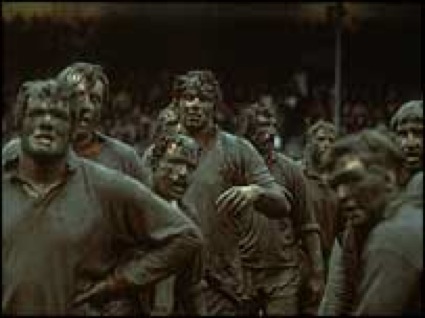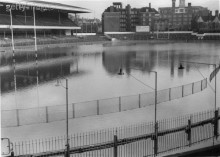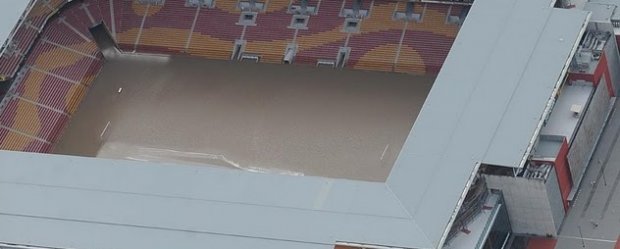
Test matches have been played in all sorts of atrocious conditions. You’ve seen some of that mainly in New Zealand or over in the United Kingdom, not so much in Australia.
In the distant past, test match venues didn’t quite have the drainage capacity that we have today. Some have even got heated underground elements, not forgetting those with roofs.
When we have to play in inclement weather, for instance like we did against Munster recently (in really appalling conditions), we’ve got a ready-made excuse for losing.
But there’s probably something to that – if we aren’t used to the conditions it becomes more of a challenge.
If we were playing a test here in sunny Queensland over the past few weeks there would be some complaints.
You would have all seen the photos of Suncorp Stadium under water (and occasionally on fire)? Here’s hoping the venue will be back in pristine condition for next month’s first up Super Rugby game.
The good news is that the iconic XXXX Brewery down the road is back in action.
There have been plenty of memorable test matches played in appalling conditions. Most have been overseas and fortunately don’t involve the Wallabies.

One of the worst ever played was at Eden Park in Auckland in 1975. It involved the All Blacks and Scotland. They called the venue ‘Lake Eden’ but the match was commonly referred to as ‘the water-polo test’.
Some famous participants included Ian Kirkpatrick, Sid Going, BJ Williams and Grant Batty for the All Blacks. For Scotland the great Andy Irvine, Ian McGeechan, Alistair McHarg and Sandy Carmichael took part.
There had been torrential downpours leading up to this match and Eden Park was completely waterlogged. There were pools of water all over the place – perhaps a shade less inundation than Suncorp Stadium.
Miraculously for the conditions, the All Blacks scored four tries on the day with two to the great Bryan Williams. To further drown the Scot’s sorrows, fullback Joe Karam kicked all four conversions.
In this day and age they would have postponed it because of health and safety concerns – someone could have drowned?
[youtube]http://www.youtube.com/watch?v=JtCn5nESB3M[/youtube]
There were many test matches played at the old Athletic Park ground in Wellington affected by wind and rain. This place was situated within spitting distance of Cook Strait (the body of water between the two islands) in Wellington South and subject to the fiercest elements.
Two of the most talked-about involved touring French teams. The first of these matches was the so-called ‘cyclone test’ of August 1961, which ended in a 5-3 victory for the All Blacks.

With the wind behind him, fullback Don Clarke aimed his conversion of Kel Tremain’s try (worth 3 points at the time) from the sideline parallel to the 25-yard line. The wind did the rest and the ball went over off the upright.
In their next test against the All Blacks at Athletic Park, in 1968, the French once more encountered Wellington at its worst. Local fans laughed when fullback Pierre Villepreux lined up a 70 yard shot at goal.
His was the last laugh, as the ball sailed between the posts on the wings of another southerly gale.
The 1995 Rugby World Cup in South Africa. The venue for the semi-final between France and the Springboks was at King’s Park in Durban.
This game was beset by fierce thunderstorms and lashings of rain. The pitch resembled a lake. Groundsmen and women with brooms desperately fought to clear the playing surface of water before the match kicked off.
Referee Derek Bevan was concerned about collapsed scrums in large pools of water.
The game’s kick-off was delayed by an hour and was touch and go, with South Africa’s eventual triumph hanging in the balance. Had the game been called off, France would have progressed to the final on the basis of a superior disciplinary record in the tournament.
As it was, the game went ahead in atrocious conditions, leaving flanker Ruben Kruger to seal the narrowest of victories (19-15) with the only try of the game.

Back in days gone by (say pre-1980’s) the authorities were reluctant to cancel or postpone rugby tests in those very bad conditions. That’s understandable.
Test matches were few and far between in those days – for instance, touring the northern hemisphere was about a four yearly cycle – and these were the respective union’s only opportunity to generate any income.
Conditions were just accepted. Players were a lot tougher and put up with more adversity than they would today. They were amateurs and touring was regarded as a huge privilege. Air travel wasn’t as reliable, comfortable or frequent as it is now.
Some of the worst conditions ever to play a rugby test took place at Cardiff Arms Park in 1960. The Springboks undertook a Grand Slam Tour of the Home Countries countries and France.
These were the days of Welsh supremacy. In this match, the conditions were absolutely awful. The photo shows Cardiff Arms Park just a few hours after the match when the River Taff broke its banks.
They played in icy-cold conditions, torrential rain and with a gale blowing. The field was a mud bath. Keith Oxlee kicked a penalty (for an incorrect feed) and they played 10 man rugby.
The hero was Eighthman Doug Hopwood, who picked up the pill at the back of every Springbok scrum and drove forward.
Ah, the sun’s now shining in my neck of the woods and the flood’s receded. Let’s hope the mud-covered footy grounds just get back to normal. Life goes on….


